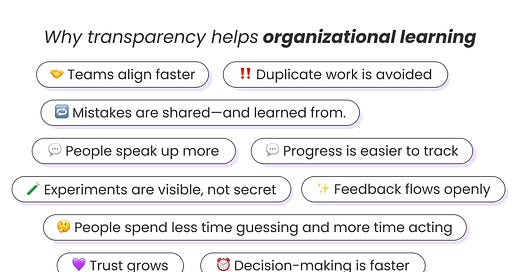Organizational learning requires transparency
Transparency fuels organizational learning by turning scattered efforts into shared progress, and assumptions into alignment.
Decisions made behind closed doors, then barely explained.
Two teams working on the same thing, unaware of each other.
Feedback collected, but never shared.
Work that's polished for leadership but never truly reflected on.
Lack of transparency.
This is one of the things that stalls organizational learning more than a lack of training ever could.
Because learning doesn’t just happen in workshops or e-learnings. It happens when people across the organization can see what’s going on, understand how decisions are made, and build on what others are doing. Without transparency, that’s almost impossible.
People end up operating with partial context. They waste time solving problems others have already solved. They stay quiet because they don’t know the full story. And slowly, the organization becomes more about execution and less about evolution.
Transparency changes that. It creates a shared sense of reality. When people have access to information, to the reasoning behind decisions, to the experiments in progress (not just the ones that succeeded), learning becomes part of the way the organization works. Not something extra, but something embedded.
That doesn’t mean chaos. It means trust. It means believing that people can handle nuance, can work with context, and can contribute more meaningfully when they’re given the full picture.
If you want a learning organization, don’t just invest in training. Invest in transparency. Because people can’t learn from what they’re not allowed to see.
If you’re finding this newsletter valuable, share it with a friend and consider subscribing if you haven’t already.




